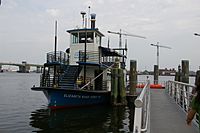Transportation in Norfolk, Virginia facts for kids
Norfolk is a very important city in Virginia, located in the southeastern part of the state. Because of its special location and how important it is for business and culture, many different ways to travel have grown around the city.
Contents
Trains: Past and Present
Long ago, in the late 1800s and early 1900s, Norfolk was a busy place for passenger trains. Three main train companies served the city, taking people to many different places. For example, the Norfolk & Western trains went west across Virginia, and the old Norfolk Southern trains went to Raleigh and Virginia Beach. Another company, the Virginian Railway, also carried passengers.
Over time, these passenger train services stopped. The Norfolk Southern trains ended by the late 1940s, and the Virginian Railway stopped in 1956. The last Norfolk & Western passenger train left Norfolk in 1971.
Today, you can still catch a train in Norfolk! Amtrak provides train service from the Norfolk station. This train line goes west to Petersburg and then continues to Richmond and other cities. There are also plans being looked at for a fast train connection from Richmond that could link to other major train routes.
Highways and Tunnels: Connecting Norfolk
In the 1950s, a new era of travel began with the creation of the Interstate Highway System. Over about 15 years, many new roads, bridges, and tunnels were built. These connected Norfolk to nearby areas like the Peninsula, Portsmouth, and Virginia Beach.
On May 23, 1952, the Downtown Tunnel opened. This tunnel connected Norfolk with Portsmouth. Later, in 1987, a second tunnel was added next to it. Today, the Downtown Tunnel has four lanes and is part of Interstate 264. In 1991, the Downtown Tunnel and Berkley Bridge area was finished, making it easier to travel with more lanes and connections.
On November 1, 1957, the Hampton Roads Bridge-Tunnel opened. This amazing structure connected the Virginia Peninsula with Norfolk. It became part of Interstate 64 by the end of that year. In 1976, a second tunnel was added, making it four lanes wide. The tolls to use this bridge-tunnel were removed in December 1976.
Another tunnel, the Midtown Tunnel, opened on September 6, 1962. It helped ease traffic by providing another way to get between Norfolk and Portsmouth.
On December 1, 1967, the Virginia Beach-Norfolk Expressway opened. This was a 12.1-mile-long (19.5 km) toll road that cost $34 million to build. Some people thought it would not be popular because of the small toll fee. However, it was a huge success! Many people started using it to travel between Norfolk and Virginia Beach. This made it easier for people to live in Virginia Beach and work in Norfolk, which is still common today. The tolls were removed on June 1, 1995, and this road also became part of I-264.
Norfolk's Road Network
Norfolk is connected to its neighbors by a large system of roads, bridges, tunnels, and bridge-tunnels. The main roads that go east and west are Interstate 64, U.S. Route 58 (Virginia Beach Boulevard), and U.S. Route 60 (Ocean View Avenue).
The main roads that go north and south are U.S. Route 13 and U.S. Route 460, also known as Granby Street. Other important roads in Norfolk include Newtown Road, Waterside Drive, Tidewater Drive, and Military Highway. The Hampton Roads Beltway, which includes I-64 and its connecting roads (I-264, I-464, and I-664), forms a loop around Norfolk.
There are also plans to extend I-495 from the Raleigh-Durham area in North Carolina to the Hampton Roads area. This new interstate would connect two large cities that currently do not have a direct interstate highway between them. In May 2016, a new interstate, Interstate 87, was approved in North Carolina. Virginia's part of I-87 is still being planned.
Getting Around Norfolk: Local Transit
Hampton Roads Transit (HRT) provides bus services and special transportation for people with disabilities. HRT buses travel all over Norfolk and the surrounding areas, even reaching Williamsburg and Smithfield.
HRT also offers a ferry service that takes people from downtown Norfolk to Old Town Portsmouth for a small fee. There are also express buses and special buses for the Norfolk Naval Base.
Norfolk also has a light rail line called The Tide. It is 7.4 miles long and has 11 stations, connecting downtown Norfolk to Newtown Road.
Air Travel, Bus Services, and Cruise Ships
Norfolk is mainly served by the Norfolk International Airport (ORF), which opened in 1938. It is the main airport for the region and is located near the Chesapeake Bay, close to the border with Virginia Beach. Many airlines fly from this airport to different cities. In 2016, over 3.7 million passengers used the airport.
Another airport, Newport News/Williamsburg International Airport, also serves the Hampton Roads area. For smaller planes, Chesapeake Regional Airport is available just outside the city.
For bus travel, Greyhound offers services from the Norfolk Amtrak station. There are also other bus services, like Today's Bus, that go to New York City.
In April 2007, Norfolk finished building a new $36 million cruise ship terminal called the Half Moone Cruise Terminal. It is located downtown next to the Nauticus museum. This modern building provides a permanent place for cruise ships and passengers to start their trips from Norfolk. Before this, temporary structures were used.



